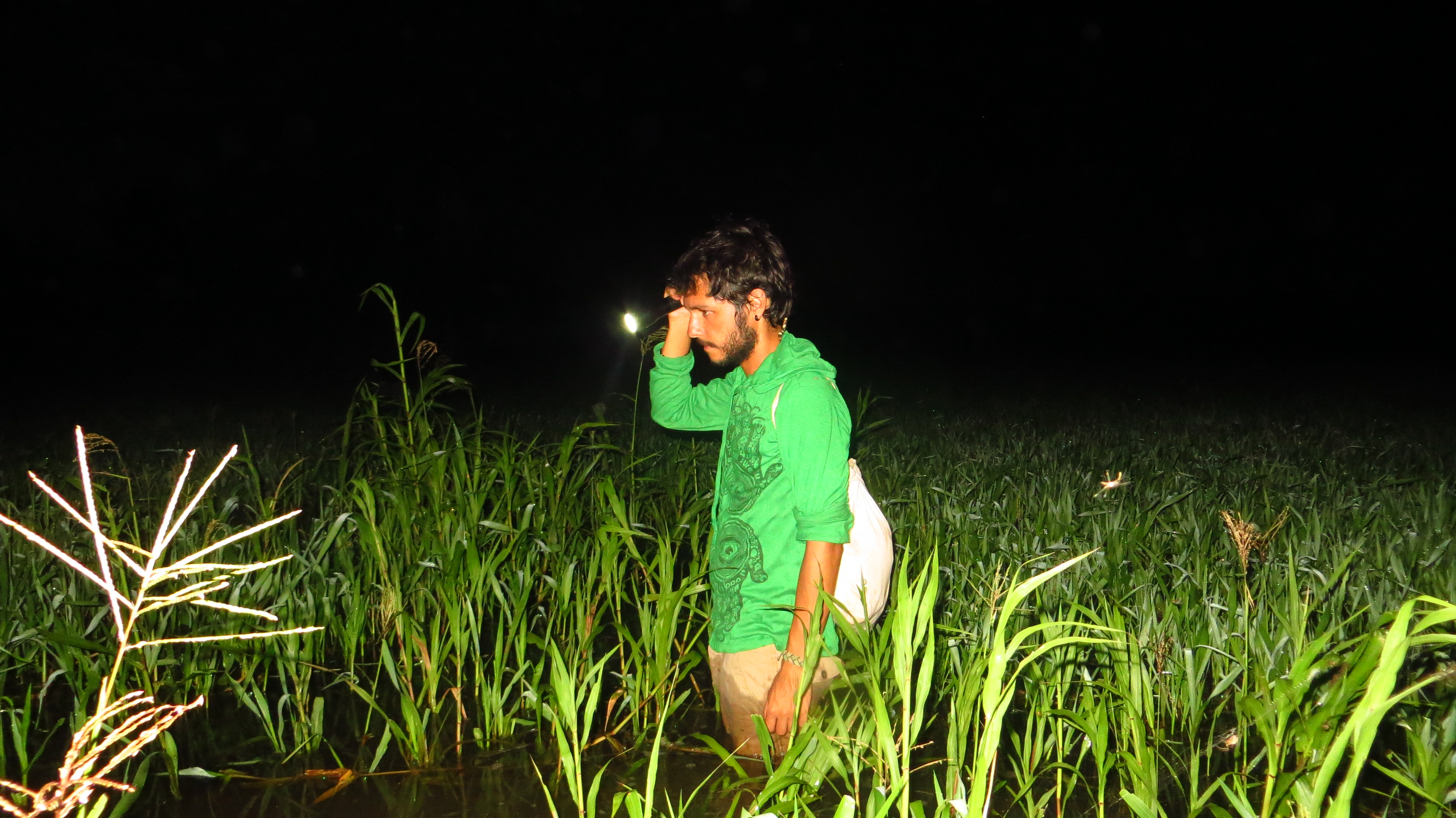What got you interested in amphibians?
I have always been amazed by what is different and exotic, by everything out of the ordinary. And that was what drew my attention to amphibians in the first place. I was amazed by their singularity, the things that make them so unique among other animals. I was also intrigued by the reason why these animals, so inoffensive and harmless, can be so feared and disliked? I wanted to know how threatened they were, and what I could do to help protect them.
What projects have you been involved in to promote amphibian conservation?
Since 2010 I have been involved in the Admirable Red-Belly Toad (Melanophryniscus admirabilis) conservation project. It is a Critically Endangered microendemic species from the southern Brazilian Atlantic Forest that until recently had been threatened by the possible implementation of a small hydroelectric power plant. Working with a multi-disciplinary and multi-institutional team, we were able to prevent the construction of the hydroelectric. In Germany, I have also helped with a project on the fire-salamander and the highly deadly chytrid fungus Batrachochytrium salamandrivorans. Moreover, since 2015 I am a Program Officer at the IUCN SSC Amphibian Specialist Group for Brazil. Over the last years, we have conducted a massive review of the conservation activities involving amphibians in our country, and have organized the I Amphibians in Focus (ANFoCO): Brazilian Symposium on Amphibian Conservation (held in São Paulo in August 2018). Since 2017 I have been involved in the Giant of the Pampas initiative, an international effort aiming for the conservation of the Ornate Horned Frog (Ceratophrys ornata) in Argentina, Uruguay, and Brazil. Finally, since the end of 2018, I have been collaborating with the Amphibian Survival Alliance as a Communication Intern, taking care of the ASA social media channels.
Can you tell us a little about your Ph.D.?
I am currently finishing my Ph.D. at the Universität Trier, in Germany, on the diversity of amphibians in the Amazonian floodplains, with a focus on the influence of floating meadows as promoters of long-distance dispersal.
What are you currently working on for ASA?
Currently, as a Communication Intern, I take care of the ASA social media channels (Facebook, Twitter, and Instagram). Our primary focus is to highlight the fantastic work conducted by our partners, to publicize opportunities (grants, jobs, prizes, events, etc.), to share recent news on amphibian conservation and to raise awareness about these amazing creatures.
What is your favourite amphibian species and why?Hard to say, since I have worked with amazing species such as the Admirable Red-Belly Toad. Oddly enough, I think my favourite species is the Montevideo Treefrog (Boana pulchella), one of the most common amphibians in the South of Brazil, where I come from. It has the most beautiful vocalization I have ever heard! They can call even at extremely low temperatures and very often its amazing choirs are the only sound to be heard throughout the cold winter nights.
Do you have a funny anecdote from your work with amphibians that you can share?
In 2009 I was searching for frogs with a good friend in the Southern Brazilian countryside. Though it was very cold outside, we heard a vocalization that I’ve never heard before coming from a small swamp next to a soybean plantation. Full of excitement, we soon spotted that small Striped Treefrog (Boana caingua) calling from the top of the single tree in the place. But it was too high for us, so I had to climb on the shoulders of my friend to be able to reach the animal. It must have been a funny scene, although there was no one to see it: a guy with water on his knees holding another one on his shoulders in a cold night in the middle of a soybean plantation! But it was worth the effort. It was a new register to that region. To take pictures in sunlight, we brought the treefrog home. Inside the car, on our way back, we heard music and when the radio played The Salmon Dance, a song by The Chemical Brothers, the treefrog started singing along to it! We were amazed! Other songs played, and the treefrog did not react. So we played The Salmon Dance again, and he vocalized again! Have you ever heard of an amphibian that liked pop songs?
What can we all do to help raise awareness of amphibians and their plight?
Before trying to change the world, let us try to change ourselves. And we can only do that by learning. The only problem with education is that knowledge brings responsibility. Currently, there is plenty of evidence that human meat-eating habits are significant drivers of climate change, deforestation, and pollution of terrestrial and aquatic ecosystems. Therefore, if we are worried about the future of amphibians and other wild animals, we should start by raising awareness of this topic and reducing our consumerism. I believe only education can give us a brighter future. People will only respect (and therefore protect) what they know, understand and identify themselves with. We have to teach children and adults about the importance of protecting the environment and, in our case, the amphibians. We have to put an end to the belief that frogs are disgusting, dangerous and associated with the dark side, to witchcraft. We have to show that they are beautiful and essential to the environmental balance; and for those who seek for an anthropocentric purpose for animals, we need to show that amphibians are also important to humankind. If you love amphibians and want to help protect them, so learn, learn, learn! And then tell other people what you have learned, show them how beautiful and important these animals are. Help educate and raise awareness!

